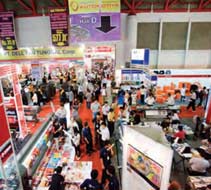Also, download this story from the electronic issue here

Forecast to become the seventh largest economy by 2030, Indonesia is expected to boldly uplift its sombre economic climate of the previous year’s rupiah decline, market volatility, and lower exports. It is against this backdrop that the 9th edition of Indoplas and 8th editions of Indoprint and Indopack shows will be held from 3-6 September 2014 at JI Expo.
In 2013, Indonesia’s economic growth had posted an unprecedented low of a growth of 5.6% from the third quarter since 2009. The Indonesian currency rupiah depreciated to more than 20% against the US dollar; lower export demand as well as market volatility and tighter external financing conditions burdened one of ASEAN’s largest economies.
The World Bank (WB), in its economic quarterly report on the country, pre-empted a continuing slow growth up to the current year. The GDP growth will crawl to 5.3% this year, driven by the softening of investment spending, growing by only 4.5% in the third quarter, reflecting mainly reductions in machinery and equipment investment, according to the global financial organisation.
Setting aside pessimism, WB says that “reversing the slower growth forecast for 2014 will require additional and more focused policy responses,” to buoy up the economy. WB also suggests addressing the deficit by increasing exports and securing higher quality external financing (i.e., FDIs) by easing trade regulations and logistics.
Despite the earlier forecasts, the Indonesian government is assuring that GDP growth will pick up to 5.5% this year, to be supported in part by an increasing household spending. According to Indonesian Finance Minister Chatib Basri, household spending holds a share of 55% of the country’s total economic growth, adding that exports this year are expected to recover in view of improving commodity prices and rising demand from major trading partners.
On the road to recovery
Indonesia’s good fate could hinge from meeting the objectives of its current economic master plan, MP3EI, of accelerating and expanding economic development in order to support its transformation to a developed country by 2025, by targeting an economic growth of 7-8% annually, apart from responding to other challenges.
The new government of newly elected President Joko Widodo embodies the redemption the country needs for it to reach its growth targets. On his agenda is for the country to rebound within two years, against the backdrop of a reform hinged on gradually easing the country’s US$21 billion fuel subsidies, which keep the local prices of fuel low, thereby allowing for more funds for infrastructure. Two key sectors, mining and energy, will get a shot in the arm, as well.
Transition resilient industry
The country is in the middle of transition, shedding off some of its old policies to give way to new ones that are deemed to encourage investments and revenue growth. Several industry sectors that comprise the non-oil and gas industry, which contributed 24% to the total GDP in 2012, have been through a rough patch over the years.
Reinforced by a sizeable population of 242 million and a growing middle class estimated at 74 million people, expected to almost double by 2020 to 141 million, Indonesia is a strong market contender in the Asian region as well as globally.
According to France-headquartered online analyst group, Global Business Guide (GBG), the country’s increased consumer purchasing power will lead to expanding growth for industries such as the packaging industry, with growth placed at 11.1% to US$4.36 billion in 2012.
GBG indicated that food and beverage, which accounts for 67% of the total packaging market value, as well as pharmaceuticals are the key sectors that will push the demand for packaging materials.
UK-headquartered BRICdata reported that the Indonesian packaging industry is expected to post a CAGR of 5.1% from 2012 to 2016, reaching a value of US$9.6 billion in 2016.
Nielsen (formerly known AC Nielsen), a US research firm, sees packaging to gain a growing demand from the middle class consumers. It adds that new household consumption will be worth US$5.3 trillion by 2020.
Meanwhile, by tapping the 130 million Indonesian consumer population aged 29 and below, for the youth-driven cosmetics sector in the country, could generate sales growth for the packaging segments, and thereby provide growth opportunities for consumer packaged goods (CPG) firms across Asia-Pacific, according to UK-based research firm Canadean.
Thus, the packaging sector will drive the country's plastics sector, which is expected to register a growth of 6% on average a year through to 2015.
Indoplas well placed for a staging
It is against this backdrop that the 9th Indonesian edition of Indoplas and 8th editions of Indoprint and Indopack for the plastic, processing, packaging and printing industries will be held from 3-6 September 2014 at JI Expo.
The show is jointly organised by Messe Düsseldorf Asia and PT Wahana Kemalaniaga Makmur (Wakeni) as well as supported by local and international bodies and associations. This includes the plastics and rubber machinery, food processing and packaging machinery, and printing and paper equipment and supplies divisions of the German Engineering Federation (VDMA).
(PRA)




















